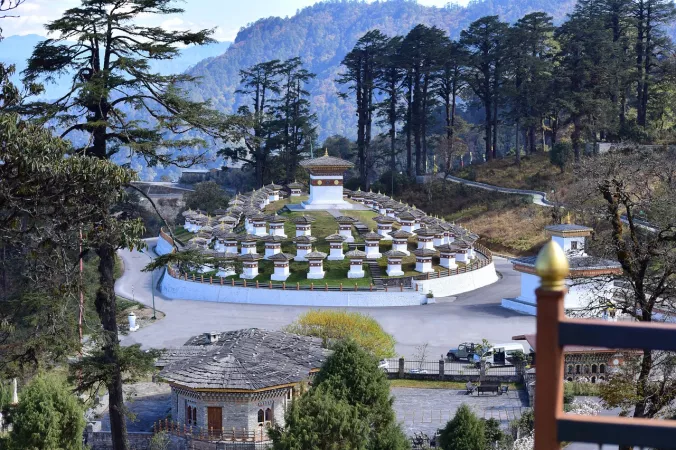
Shanti Stupa Travel Guide
Shanti Stupa, located in the picturesque city of Leh in Ladakh, India, is a symbol of peace and spirituality. Built to promote world peace and prosperity, this white-domed stupa offers stunning panoramic views of the surrounding mountains and valleys. The destination holds immense historical significance as it was inaugurated by the 14th Dalai Lama in 1985. Shanti Stupa is famous for its serene ambiance, spiritual vibes, and breathtaking sunsets that attract visitors from all over the world.Top Attractions in Shanti Stupa
- Shanti Stupa
- Leh Palace
- Pangong Lake
- Nubra Valley
- Hemis Monastery
Shanti Stupa is Famous for
Peace and spiritualityTop Attractions in Shanti Stupa
- Experience the tranquility of Shanti Stupa
- Explore the ancient Leh Palace
- Marvel at the beauty of Pangong Lake
- Visit the surreal Nubra Valley
- Discover the cultural richness of Hemis Monastery
What's Great about Travelling to Shanti Stupa?
- Peaceful and serene environment
- Spiritual and cultural experiences
- Breathtaking natural beauty
What's Not So Great about Travelling to Shanti Stupa?
- High altitude, may cause altitude sickness
- Limited accommodation options
- Harsh weather conditions
Travel Tips for Shanti Stupa
- Acclimatize to the high altitude before exploring
- Carry necessary medications for altitude sickness
- Dress warmly for the cold weather
Important Shanti Stupa trip information
- Ideal Duration: 3-4 days
- Best Time to Visit: May to September
- Nearby Airports and Railway Stations: Leh Airport and Jammu Tawi Railway Station
FAQ's on Shanti Stupa
Q1: What is the best time to visit Shanti Stupa?
The best time to visit Shanti Stupa is during the months of October to March when the weather is pleasant and ideal for sightseeing. Avoid the monsoon season from June to September due to heavy rainfall. Consider visiting during special events like the annual Hemis Festival in July for a cultural experience.
Q2: Do I need a visa to travel to Shanti Stupa?
Most visitors to Shanti Stupa will need a tourist visa to enter the country. Check with the nearest embassy or consulate for specific requirements. Some nationalities may be eligible for visa-on-arrival or e-visa facilities, so it's recommended to research and apply in advance.
Q3: What are the must-visit attractions in Shanti Stupa?
Must-visit attractions in Shanti Stupa include the iconic Shanti Stupa itself, Leh Palace, Pangong Lake, Nubra Valley, and Hemis Monastery. Explore the vibrant markets of Leh and indulge in adventure activities like trekking and river rafting.
Q4: Is Shanti Stupa a safe place to travel?
Shanti Stupa is generally considered safe for tourists. However, it's advisable to respect local customs, avoid isolated areas at night, and be cautious of altitude sickness due to the high elevation. Stay informed about weather conditions and follow travel advisories.
Q5: What is the local currency in Shanti Stupa and can I use credit cards?
The local currency in Shanti Stupa is the Indian Rupee (INR). While major cities and tourist areas may accept credit cards, it's recommended to carry cash for smaller establishments and local markets. ATMs are available in Leh for convenient withdrawals.
Q6: What is the local cuisine like in Shanti Stupa?
offers a diverse culinary experience with Tibetan, Ladakhi, and Indian influences. Try local dishes like Thukpa (noodle soup), Momos (dumplings), and Butter Tea. Vegetarian options are widely available, but be mindful of spicy foods if you have dietary restrictions.
Q7: What transportation options are available in Shanti Stupa?
Transportation options in Shanti Stupa include taxis, auto-rickshaws, and rental cars for exploring the region. Public buses are available for inter-city travel, while shared taxis are a common mode of transportation for short distances. Consider hiring a local guide for seamless travel experiences.
Q8: Are there any cultural norms or etiquette I should be aware of when visiting Shanti Stupa?
Respect local customs in Shanti Stupa by dressing modestly, removing shoes before entering religious sites, and seeking permission before taking photographs of locals. Greet people with a 'Julley' (hello) and be mindful of environmental conservation practices. Embrace the traditional Ladakhi culture with humility and appreciation.
Q9: I am a travel agent. How can I buy travel leads of Shanti Stupa?
Register yourself as a travel agent at agents.tripclap.com and then you can buy travel leads to Shanti Stupa once your account is approved. For more details contact our support team at +91-8069186564 or support@tripclap.com
